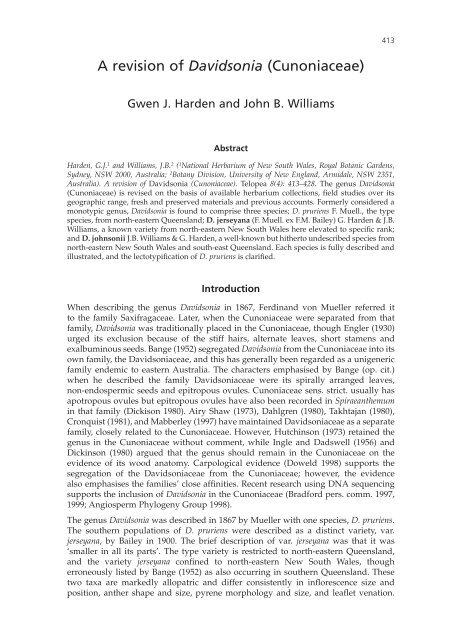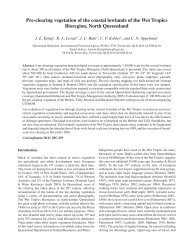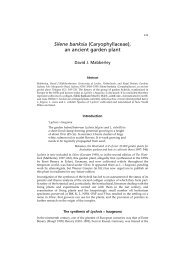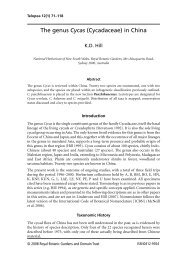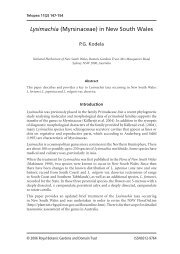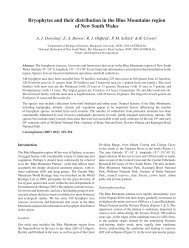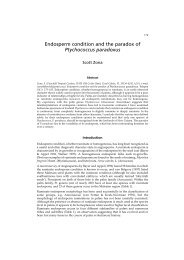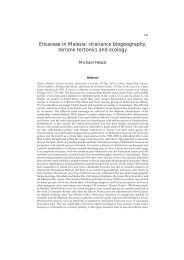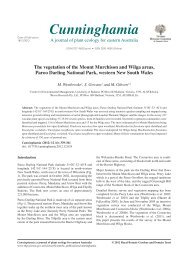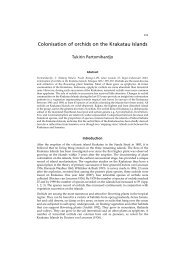A revision of Davidsonia (Cunoniaceae) - Royal Botanic Gardens ...
A revision of Davidsonia (Cunoniaceae) - Royal Botanic Gardens ...
A revision of Davidsonia (Cunoniaceae) - Royal Botanic Gardens ...
Create successful ePaper yourself
Turn your PDF publications into a flip-book with our unique Google optimized e-Paper software.
A <strong>revision</strong> <strong>of</strong> <strong>Davidsonia</strong> (<strong>Cunoniaceae</strong>)<br />
Gwen J. Harden and John B. Williams<br />
Abstract<br />
Harden, G.J. 1 and Williams, J.B. 2 ( 1 National Herbarium <strong>of</strong> New South Wales, <strong>Royal</strong> <strong>Botanic</strong> <strong>Gardens</strong>,<br />
Sydney, NSW 2000, Australia; 2 Botany Division, University <strong>of</strong> New England, Armidale, NSW 2351,<br />
Australia). A <strong>revision</strong> <strong>of</strong> <strong>Davidsonia</strong> (<strong>Cunoniaceae</strong>). Telopea 8(4): 413–428. The genus <strong>Davidsonia</strong><br />
(<strong>Cunoniaceae</strong>) is revised on the basis <strong>of</strong> available herbarium collections, field studies over its<br />
geographic range, fresh and preserved materials and previous accounts. Formerly considered a<br />
monotypic genus, <strong>Davidsonia</strong> is found to comprise three species; D. pruriens F. Muell., the type<br />
species, from north-eastern Queensland; D. jerseyana (F. Muell. ex F.M. Bailey) G. Harden & J.B.<br />
Williams, a known variety from north-eastern New South Wales here elevated to specific rank;<br />
and D. johnsonii J.B. Williams & G. Harden, a well-known but hitherto undescribed species from<br />
north-eastern New South Wales and south-east Queensland. Each species is fully described and<br />
illustrated, and the lectotypification <strong>of</strong> D. pruriens is clarified.<br />
Introduction<br />
When describing the genus <strong>Davidsonia</strong> in 1867, Ferdinand von Mueller referred it<br />
to the family Saxifragaceae. Later, when the <strong>Cunoniaceae</strong> were separated from that<br />
family, <strong>Davidsonia</strong> was traditionally placed in the <strong>Cunoniaceae</strong>, though Engler (1930)<br />
urged its exclusion because <strong>of</strong> the stiff hairs, alternate leaves, short stamens and<br />
exalbuminous seeds. Bange (1952) segregated <strong>Davidsonia</strong> from the <strong>Cunoniaceae</strong> into its<br />
own family, the <strong>Davidsonia</strong>ceae, and this has generally been regarded as a unigeneric<br />
family endemic to eastern Australia. The characters emphasised by Bange (op. cit.)<br />
when he described the family <strong>Davidsonia</strong>ceae were its spirally arranged leaves,<br />
non-endospermic seeds and epitropous ovules. <strong>Cunoniaceae</strong> sens. strict. usually has<br />
apotropous ovules but epitropous ovules have also been recorded in Spiraeanthemum<br />
in that family (Dickison 1980). Airy Shaw (1973), Dahlgren (1980), Takhtajan (1980),<br />
Cronquist (1981), and Mabberley (1997) have maintained <strong>Davidsonia</strong>ceae as a separate<br />
family, closely related to the <strong>Cunoniaceae</strong>. However, Hutchinson (1973) retained the<br />
genus in the <strong>Cunoniaceae</strong> without comment, while Ingle and Dadswell (1956) and<br />
Dickinson (1980) argued that the genus should remain in the <strong>Cunoniaceae</strong> on the<br />
evidence <strong>of</strong> its wood anatomy. Carpological evidence (Doweld 1998) supports the<br />
segregation <strong>of</strong> the <strong>Davidsonia</strong>ceae from the <strong>Cunoniaceae</strong>; however, the evidence<br />
also emphasises the families’ close affinities. Recent research using DNA sequencing<br />
supports the inclusion <strong>of</strong> <strong>Davidsonia</strong> in the <strong>Cunoniaceae</strong> (Bradford pers. comm. 1997,<br />
1999; Angiosperm Phylogeny Group 1998).<br />
The genus <strong>Davidsonia</strong> was described in 1867 by Mueller with one species, D. pruriens.<br />
The southern populations <strong>of</strong> D. pruriens were described as a distinct variety, var.<br />
jerseyana, by Bailey in 1900. The brief description <strong>of</strong> var. jerseyana was that it was<br />
‘smaller in all its parts’. The type variety is restricted to north-eastern Queensland,<br />
and the variety jerseyana confined to north-eastern New South Wales, though<br />
erroneously listed by Bange (1952) as also occurring in southern Queensland. These<br />
two taxa are markedly allopatric and differ consistently in inflorescence size and<br />
position, anther shape and size, pyrene morphology and size, and leaflet venation.<br />
413
414 Telopea 8(4): 2000<br />
It is considered appropriate that variety jerseyana should be given specific rank. This<br />
follows the evolutionary species concept as outlined by Wiley (1978, 1981), in which<br />
morphologically different allopatric lineages should be given specific rank. A third<br />
taxon occurring in New South Wales and southern Queensland is very distinct from<br />
the above two taxa in several characters and is here described as a new species.<br />
Three collections <strong>of</strong> <strong>Davidsonia</strong> (at NSW) made in 1926, 1939 and 1944 from northeastern<br />
New South Wales were segregated by L.A.S. Johnson in June 1949 and labelled<br />
‘clearly a new species’. We concur with this view and the species is here described as<br />
<strong>Davidsonia</strong> johnsonii J.B. Williams & G. Harden. D. johnsonii is largely sympatric with<br />
D. jerseyana (Fig. 4) but no intermediates are known. It differs from the specimens <strong>of</strong><br />
D. pruriens var. jerseyana in several characters including growth habit, leaf size, form<br />
and pubescence, and fruit shape and size, and also differs in its reproductive method<br />
in that no seeds are known to be formed. This species was not apparently collected<br />
between 1944 and 1977 when it was rediscovered by Graham Watson growing on his<br />
property at Huonbrook near Mullumbimby, and drawn to the attention <strong>of</strong> the authors<br />
in 1978. However, a specimen had been collected by A.G. Floyd and H.C. Hayes in<br />
1958 at The Pocket and deposited at the C<strong>of</strong>fs Harbour Forestry Herbarium (CFSHB)<br />
and Floyd and Hayes (1961) stated that ‘a possible new species at Mooball near<br />
Murwillumbah is quite glabrous’. Since that time collections have been made from<br />
18 localities in north-eastern New South Wales and three in south-eastern Queensland.<br />
The taxon was informally described or listed as a new species in the following<br />
publications (Williams 1979, Williams & Harden 1979, Williams et al. 1984, Floyd<br />
1981,1989 and Harden 1990), with the descriptions <strong>of</strong> the flowers and fruit in<br />
Floyd (op. cit.) based on information provided by one <strong>of</strong> the authors (J.B.W.).<br />
In recent years some specific studies at the University <strong>of</strong> New England have involved<br />
examination <strong>of</strong> the <strong>Davidsonia</strong> taxa in New South Wales. They have concentrated on<br />
their conservation and development (Watson 1987) and the pollination <strong>of</strong> <strong>Davidsonia</strong><br />
pruriens var. jerseyana (Elliott 1991). Also, various surveys have been undertaken<br />
<strong>of</strong> both these taxa in New South Wales to establish the distribution and size <strong>of</strong> the<br />
populations as part <strong>of</strong> the ongoing documentation and management <strong>of</strong> species that<br />
are considered to be rare or threatened (Briggs and Leigh 1988, 1996) or listed in the<br />
schedules <strong>of</strong> the New South Wales Threatened Species Conservation Act, 1995. These<br />
studies and surveys have either been prepared as thesis requirements for postgraduate<br />
courses and have not been published, or have been prepared as internal<br />
reports for the National Parks and Wildlife Service <strong>of</strong> New South Wales (Quinn<br />
et al. 1996). One <strong>of</strong> the authors (J.B.W.) has been involved in each <strong>of</strong> these studies<br />
and surveys.<br />
Fresh material from plants growing at the <strong>Royal</strong> <strong>Botanic</strong> <strong>Gardens</strong> Sydney was used<br />
for the illustrations. These were supplemented with preserved mature fruits <strong>of</strong><br />
D. jerseyana from Mooball.<br />
<strong>Davidsonia</strong> F. Muell.<br />
Mueller (1867: 4); Bailey (1900: 537); Bange (1952: 294); Harden (1990: 523).<br />
Type species: <strong>Davidsonia</strong> pruriens F. Muell.<br />
Small trees to 20 m high, usually in rainforest, either with one or a few sparingly<br />
branched stems or a dense-foliaged much-branched canopy; leaves <strong>of</strong>ten tufted<br />
towards the end <strong>of</strong> stems. Indumentum either prominent and persistent on all or most<br />
parts, or inconspicuous or absent on mature parts. Seedling leaves simple, serrate;<br />
first pair <strong>of</strong> seedling leaves opposite, narrow-elliptic; following seedling leaves
Harden and Williams, <strong>Davidsonia</strong> (<strong>Cunoniaceae</strong>) 415<br />
alternate, pinnate with an increasing number <strong>of</strong> pinnae (3–7), rachis becoming winged.<br />
Adult leaves alternate, imparipinnate, petiolate; rachis winged with the wing or winglike<br />
segments dentate; stipules paired, amplexicaul, semi-circular; pinnae sessile<br />
or shortly stalked, narrow-obovate to narrow-ovate in general outline; terminal<br />
pinna usually the largest, with pinnae pairs progressively smaller towards base <strong>of</strong><br />
leaf; petiolulate or sessile; stipellae usually present at base <strong>of</strong> pinnae. Inflorescences<br />
cauliflorous, ramiflorous or subterminal and borne amongst the leaves, paniculate<br />
and open or congested and spike-like. Flowers bisexual, 4- or 5-merous; sepals 4 or 5,<br />
petaloid, pink or red, connate in the basal half, valvate in bud; petals absent; stamens<br />
usually 8 or 10, exserted beyond the sepals, alternating with an equal number <strong>of</strong><br />
nectaries; carpels 2 or rarely 3, ovary bilocular or rarely trilocular, ovules 5–7 in each<br />
loculus, styles 2 or rarely 3; ovules anatropous; in one species (D. johnsonii) the flowers<br />
are <strong>of</strong>ten sterile, with styles reduced or absent and anthers without pollen. Fruit a<br />
drupe, mesocarp fleshy; pyrenes 2 or rarely 3, compressed, pyrene wall cartilaginous<br />
to semi-woody; body <strong>of</strong> pyrene with s<strong>of</strong>t fibres extending radially from margins,<br />
dorsally keeled and terminally crested; seed solitary or absent, glossy dark reddish<br />
brown to black, strongly compressed, plano-convex, glabrous, broad-ovate to circular,<br />
apex obtuse with a prominent short point at radicle end; endosperm absent.<br />
The pyrenes lie separately in the fleshy mesocarp and have sometimes been<br />
misinterpreted as seeds (e.g. Bailey 1898, Elliott & Jones 1984).<br />
Three types <strong>of</strong> trichomes are present: (1) glandular trichomes, multicellular and<br />
multiseriate, capitate, red-tipped, <strong>of</strong>ten terminating teeth on bracts, rachis wings,<br />
margins <strong>of</strong> stipules and pinnae; (2) bristly trichomes (surfaces hirsute, only in<br />
D. pruriens and D. jerseyana) fawn to yellowish or pinkish on young growth, irritant,<br />
<strong>of</strong>ten on leaves, stems, rachises, outer surface <strong>of</strong> sepals and on fruit; (3) short s<strong>of</strong>t<br />
hairs (surfaces s<strong>of</strong>tly pubescent) as on the inner surface <strong>of</strong> sepals (and outer surface in<br />
D. johnsonii).<br />
Key to the species<br />
1 Leaflets, rachis, branchlets, inflorescence axes and outer surface <strong>of</strong> sepals hirsute,<br />
at least when young, with long irritant bristly hairs (usually moderately to strongly<br />
persistent); most adult leaves more than 35 cm long; pinnae (7–)9–19, the three<br />
largest pinnae (terminal and subterminal) 20–40 cm long; margins <strong>of</strong> pinnae<br />
secondarily serrate; inflorescences cauliflorous or ramiflorous, usually borne on<br />
the main trunks or sometimes among the leaves; styles 2 or rarely 3, conspicuous,<br />
curved, exceeding the stamens; fruit pyriform to obovoid or ellipsoid, with length<br />
greater than or equal to its diameter.<br />
2 Inflorescences open, paniculate, usually more than 30 cm long; anthers oblong<br />
at anthesis, 1.8–3.0 mm long; pyrenes (when fertile, i.e. containing a seed) 2.0–2.7<br />
cm long, 2.5–2.9 cm wide with a prominent dorsal crest 3.0–6.0 mm long; adult<br />
leaves usually 60–120 cm long, rachis scarcely winged; upper lateral pinnae<br />
mostly lanceolate to oblong, with 15–27 pairs <strong>of</strong> secondary veins .........................<br />
.............................................................................................................................................<br />
................................................................................................. 1. <strong>Davidsonia</strong> pruriens<br />
2* Inflorescences condensed, racemose or spike-like, mostly less than 25 cm long;<br />
anthers ellipsoid at anthesis, 1.1–1.7 mm long; pyrenes (when fertile) 2.0–2.2 cm<br />
long, 1.6–1.7 cm wide, with an inconspicuous crest 2.0–2.3 mm long; adult leaves<br />
usually 35–60 cm long, rachis usually prominently winged; upper lateral pinnae<br />
mostly oblanceolate, with 11–17 pairs <strong>of</strong> secondary veins. ......................................<br />
.............................................................................................. 2. <strong>Davidsonia</strong> jerseyana
416 Telopea 8(4): 2000<br />
1* All parts more or less glabrous, sometimes pubescent when young but glabrescent,<br />
hairs not irritant; leaves mostly less than 35 cm long; pinnae 5–9, the three largest<br />
pinnae (terminal and subterminal) usually 10–20 cm long; margins <strong>of</strong> pinnae<br />
dentate but not secondarily serrate; inflorescences subterminal on branchlets,<br />
borne amongst the leaves; styles reduced or absent, if present 2 or 3, shorter than<br />
or scarcely exceeding the stamens; fruit depressed-globose, with length less than<br />
diameter. ................................................................................ 3. <strong>Davidsonia</strong> johnsonii<br />
1. <strong>Davidsonia</strong> pruriens F. Muell.<br />
Mueller (1867: 4, t. XLVI); Bailey (1900: 538); Bange (1952: 294–296).<br />
[<strong>Davidsonia</strong> pungens was listed in Gardeners’ Chronicle in 1876, p.603, but without the<br />
author’s name. This was given as a north Australian plant and from the description is<br />
referred to this species.]<br />
Type citation: ‘In silvis irriguis ad sinum Rockingham’s Bay. Dallachy’<br />
Lectotype: designated by Bange (1952: 296) as Murray’s River, Rockingham Bay:<br />
Dallachy, 12 Aug 1866, a MEL collection with flowers and fruit. As there are nine sheets<br />
at MEL in type folders we propose that MEL 106575 be the lectotype, thus restricting<br />
lectotypification to a single specimen, in line with the recent addition to Article 9 <strong>of</strong> the<br />
Code. This specimen was annotated by Bange, it consists <strong>of</strong> portion <strong>of</strong> a leaf and fruit<br />
and it has a copy <strong>of</strong> the original notes <strong>of</strong> Dallachy with the date 12 th August 1866. See<br />
full discussion after species description.<br />
Illustrations: Mueller (1867: t. XLVI), Bailey (1898: t. XXXVII), Bange (1952: 295),<br />
Cronquist (1981: 549).<br />
Small slender rainforest tree to 18 m high; bark brown to dark grey, becoming flaky.<br />
Indumentum prominent on all parts, young growth pinkish, hairs long, irritant;<br />
red gland-tipped trichomes terminating teeth on margins <strong>of</strong> stipules and stipellae.<br />
Seedling leaves at first simple, margins dentate; becoming more or less lobed at base<br />
and pinnate after 12 months growth; hirsute and with some reddish glandular hairs<br />
present on stipules. Adult leaves (30–)60–120(–150) cm long; petiole 10–30 cm long;<br />
15–30 mm diam., margins dentate; stipellae 5–8 mm long, narrow-lanceolate to<br />
lanceolate, sometimes divided and 2-lobed from base, margins dentate, withering and<br />
appearing spinose on older leaves; rachis slightly winged adaxially, wing continuous<br />
or as separated segments, 1–3 mm wide, segments usually absent from petiole; pinnae<br />
(7–)9–19; terminal pinna obovate and tapering into petiolule, lateral pinnae lanceolate<br />
to oblong or to oblong-ovate or oblong-obovate with basal pair <strong>of</strong> pinnae broad-ovate<br />
to ovate; apex acute to shortly acuminate; base rounded and ± equal in upper lateral<br />
pinnae, unequal in basal pinnae; margins secondarily serrate, each tooth with a hairlike<br />
point; upper surface dark green and slightly glossy, sparsely hirsute, lower surface<br />
fawn-hirsute; secondary veins 15–27 pairs, prominent on both surfaces; largest pinnae<br />
(terminal and subterminal) (12–)18–35(–46) cm long, (6–)8–12(–16) cm wide; petiolules<br />
0–5 mm long, up to 40 mm long on terminal pinnae. Inflorescences mostly cauliflorous<br />
or ramiflorous, rarely borne amongst the leaves, pendent, 12–80 cm long; peduncle<br />
(3–)10–18(–30) cm long; number <strong>of</strong> lateral spikes 2–24, 2–20 cm long; pedicels 1–5<br />
mm long; bracts amplexicaul, c. 5 mm long; bracteoles sessile, 3–5 mm long. Flowers<br />
4- or 5-merous; sepals 5.0–8.0 mm long, recurved, basally connate, dark pink, outer<br />
surface hirsute, inner surface pubescent, persistent in fruit; stamens 4.5–7.0 mm long,<br />
filaments 3.5–4.6 mm long, anthers oblong, 2.0–3.0 mm long, yellow; ovary 2.3–3.0<br />
mm long, hirsute; styles 2 (or 3), divided almost to base, 5.0–8.0 mm long, glabrous.<br />
Fruit obovoid or ellipsoid, laterally compressed, 38–55 mm long, 32–53 mm wide,
Harden and Williams, <strong>Davidsonia</strong> (<strong>Cunoniaceae</strong>) 417<br />
35–46 mm deep; blue-black, glaucous, indumentum sparse at maturity (hairs visible<br />
with hand-lens); mesocarp dark red; pyrenes usually 2, strongly laterally compressed,<br />
3.0–6.0 mm long, fimbriate with radiating s<strong>of</strong>t fibres attached to the pyrene body;<br />
pyrene body 1.5–2.3 cm long, 1.5–2.1 cm wide, crest 5.0–10.0 mm long; seed ovate to<br />
broad-ovate, 1.7–1.8 cm long, 1.2–1.4 cm wide, 3–4 mm deep. (Fig. 1).<br />
Habitat and distribution: widespread in tropical rainforest in north-eastern Queensland,<br />
chiefly from Cardwell area to Cooktown and inland to near Atherton (Fig. 2). It grows<br />
from near sea level to altitudes <strong>of</strong> over 1000 m. Bange (1952) erroneously cited this<br />
taxon as occurring in New South Wales. This taxon has been collected in Fiji (Batiki,<br />
Naduruloulou) in 1949 by B. Parham (Parham 1972: 125) where it was cultivated at the<br />
Agricultural Experimental Garden (Bange 1952).<br />
Phenology: chiefly flowers February to July, but recorded most months; with fruit ripe<br />
mostly March to June, but recorded throughout the year.<br />
Conservation status: due to its widespread distribution it is not considered to be<br />
under threat; it is known to occur in a number <strong>of</strong> conservation areas, e.g. Lake Eacham<br />
National Park, Bellenden Ker National Park (now part <strong>of</strong> Wooroonooran National<br />
Park).<br />
Discussion: this species is widely cultivated as an ornamental tree and for its edible<br />
fruits. As early as the 19th century (Bailey 1895, 1898) this species was recommended<br />
for cultivation because <strong>of</strong> its edible fruits.<br />
Discussion <strong>of</strong> lectotype: the lectotype was designated by Bange (1952: 296) as<br />
Murray’s River, Rockingham Bay: Dallachy, 12 Aug 1866, a MEL collection with<br />
flowers and fruit. There is no specimen at MEL that matches the original citation <strong>of</strong><br />
Mueller; however, there are nine sheets at MEL in type folders collected by Dallachy at<br />
Rockingham Bay in 1866. Of these nine sheets only one has been annotated by Bange<br />
(MEL 106575); this sheet has the upper portion <strong>of</strong> a leaf and fruit with a National<br />
Herbarium <strong>of</strong> Victoria label, annotated ‘Fragment <strong>of</strong> Type’ with notes <strong>of</strong> Dallachy’s<br />
copied from MEL 106543. This sheet also has the following note: ‘Dallachy made more<br />
than one collection <strong>of</strong> this species, as these five sheets <strong>of</strong> types housed here include<br />
flowers, fruits & foliage all with similar labels’. This label was not an original label<br />
and the notes appear to have been copied in recent years (perhaps before the specimen<br />
was seen by Bange in 1952). It also has a small label by Mueller with the name<br />
<strong>Davidsonia</strong> pruriens.<br />
The specimen (MEL 106543) which has the original <strong>of</strong> the notes on the habit <strong>of</strong> the<br />
plant by Dallachy, including the date <strong>of</strong> 12 August 1866, also has a Phytologic Museum<br />
<strong>of</strong> Melbourne label in Mueller’s hand with ‘<strong>Davidsonia</strong> pruriens Ferd. von Mueller,<br />
Murray’s River at Rockinghams Bay, Dall.’; the sheet has more recently been labelled<br />
‘Sheet 1 <strong>of</strong> 2’; this specimen is <strong>of</strong> the lower part <strong>of</strong> a leaf. Sheet 2 <strong>of</strong> 2 (MEL 106542)<br />
has the upper part <strong>of</strong> a leaf and a <strong>Botanic</strong>al Museum <strong>of</strong> Melbourne label in<br />
Mueller’s hand.<br />
It is apparent that the specimens that were cited by Bange in 1952 have since been<br />
remounted and possibly rearranged so that the specimen designated as the lectotype<br />
(flowers and fruit) can no longer be identified as the one nominated by Bange. MEL<br />
106546 is the only specimen that has an inflorescence and fruit and a label ‘<strong>Davidsonia</strong><br />
pruriens’ in Mueller’s writing and a later National Herbarium <strong>of</strong> Victoria label with the<br />
species name, locality as ‘Rockingham Bay, Q’land’, collector as J. Dallachy and date as<br />
‘?1866’. We choose not to nominate this specimen as the lectotype; instead we choose<br />
to restrict the lectotypification to a single specimen, MEL 106575. This is in accordance
418 Telopea 8(4): 2000<br />
e<br />
a<br />
d<br />
f h<br />
i k<br />
j<br />
Fig. 1. D. pruriens. a, adult leaf (× 0.1); b, stipules (× 0.5); c, rachis, pinnae bases, stipellae (× 1.5);<br />
d, inflorescence, diagramatic (× 0.1); e, part inflorescence (× 0.5); f, stamens (× 8); g, flower in L.S.<br />
(× 3); h, flower (× 3); i, drupe (× 0.5): j, drupe in L.S. (× 0.5); k, pyrene (× 1); l, pyrene in L.S. (× 1);<br />
m, seed (× 1); n, embryo (× 1); o, embryo showing 2 cotyledons (× 1).<br />
g<br />
m<br />
o<br />
b<br />
c<br />
n<br />
l
Harden and Williams, <strong>Davidsonia</strong> (<strong>Cunoniaceae</strong>) 419<br />
with the proposed amendment to Article 9 <strong>of</strong> the Code (Brummit 1998) which was<br />
approved, in a slightly modified form, by the XVI International <strong>Botanic</strong>al Congress.<br />
This specimen was annotated by Bange, it consists <strong>of</strong> portion <strong>of</strong> a leaf and fruit and it<br />
has a copy <strong>of</strong> the original notes <strong>of</strong> Dallachy with the date 12 th August 1866.<br />
Common names: names used for this taxon include <strong>Davidsonia</strong>n Plum by Bailey<br />
(1898), Ooray by the Tully River aborigines (Bailey 1900), Davidson’s Plum (Mabberley<br />
1997).<br />
Selected specimens (from c. 36 examined): Queensland: Cook: Endeavour River, Persieh s.n.,<br />
1884 (MEL 106561); Bloomfield River, Barnard s.n. (MEL 106570); Daintree River, Pentzke s.n.,1882<br />
(MEL 106557); near Lake Barrine, 10 miles [16 km] E. <strong>of</strong> Atherton, Melville 3683, Pont & Stephens, 9<br />
Apr 1953 (NSW, BRI, K, MEL); Lake Eacham, Atherton Tableland, 17°17'S, 145°37'E, Williams s.n.,<br />
29 Oct. 1987 (NE 61704); Copper Lode Falls Dam Site, on Freshwater Creek, approx. 6 miles<br />
[9.5 km] S <strong>of</strong> Cairns, Gittins 2139, 22 Aug 1970 (BRI); Mt Bellenden-Ker, Mueller s.n., 1893<br />
(NSW 104896, MEL); State Forest Reserve 185, Danbulla, Doggrell s.n., 28 Sept 1929 (BRI 333062, L).<br />
North Kennedy: Tully, margin <strong>of</strong> Mitchell Park by stream, Clemens s.n., Dec 1949 (BRI 134733)<br />
Fig. 2. Distribution <strong>of</strong> D. pruriens (▲).
420 Telopea 8(4): 2000<br />
2. <strong>Davidsonia</strong> jerseyana (F. Muell. ex F.M. Bailey) G. Harden & J.B. Williams, comb.<br />
et stat. nov.<br />
<strong>Davidsonia</strong> pruriens F. Muell. var. jerseyana F. Muell. ex F.M. Bailey, Queensland Flora 2:<br />
538; Bange (1952: 296).<br />
Type citation: ‘Towards Tweed River’<br />
Lectotype (Bange 1952: 296): New South Wales: North Coast: Richmond River;<br />
Baeuerlen s.n., Oct 1892 (BRI 11134).<br />
Illustrations: Bange (1952: 295); Williams & Harden (1979:15); Harden (1990: 523).<br />
Slender small trees to 6(–10) m high, unbranched or few-branched or with several<br />
stems from the base, each bearing a terminal tuft <strong>of</strong> leaves; bark brown, corky and<br />
somewhat scaly. Indumentum persistent on most parts, dense on young fruit and<br />
shoots, hairs erect, pale brown, irritant; glandular hairs present on margins <strong>of</strong> stipules.<br />
Seedling leaves at first simple, margins dentate and becoming lobed at base, becoming<br />
pinnate after 12 months growth, hirsute, with some reddish glandular hairs present<br />
on stipules. Adult leaves (25–)35–80(–120) cm long; petiole 5–20 cm long; rachis<br />
prominently winged adaxially, wing continuous or as separated segments, (1–)3–4<br />
(–5) mm wide, becoming more separated on lower rachis as stipella-like outgrowths,<br />
similarly on petiole, margins irregularly dentate, teeth ± spinose; pinnae (7–)11–17<br />
(–19); stipules, 10–30 mm diam., margins dentate; terminal pinna obovate to oblongobovate<br />
to elliptic, lateral pinnae mostly oblanceolate to oblong-oblanceolate, with<br />
basal pinnae ± elliptic, apex acute to acuminate, base tapered and ± equal in upper<br />
pinnae, unequal in lower pinnae, upper surface dark green and dull, sparsely hirsute,<br />
lower surface dull and ± hirsute; margins secondarily serrate, each tooth with a hairlike<br />
point; secondary veins 11–17 pairs, prominently raised on both surfaces; terminal<br />
and subterminal pinnae largest, (6–)20–30(–40) cm long, lower pinnae (3–)6–10(–15.5)<br />
cm wide; petiolules 1–3 mm long; stipellae present at base <strong>of</strong> most pinnae, lanceolate,<br />
3–11 mm long, 3–5 mm wide, lower stipellae <strong>of</strong>ten 3-lobed, margins glandular-toothed.<br />
Inflorescences usually cauliflorous, mostly lateral on main stems, pendent, compressed<br />
panicles, <strong>of</strong>ten appearing as tight clusters; 4–10(–30) cm long, peduncle 3–6 cm long,<br />
pedicels 1–3 mm long; bracts amplexicaul, 5.0–7.0 mm long, bracteoles sessile 3.0–4.0<br />
mm long. Flowers 4- or 5-merous; sepals 4–6 mm long, basally connate, dark pink to<br />
red, outer surface bristly-hirsute, inner surface pubescent, recurved, persistent in fruit;<br />
stamens 10, 4.5–6.5 mm long; filaments 4.1–5.5 mm long, anthers ellipsoid, 1.1–1.7<br />
mm long, yellow; ovary 1.5–2.6 mm long, styles usually 2, divided to base, 4.4–5.6<br />
mm long, glabrous; stigmas minutely capitate. Fruit pyriform to obovoid, laterally<br />
compressed, 33–45 mm long, 31–37 mm wide, 27–35 mm deep, blue to black, glaucous;<br />
young fruits hirsute, mature fruits sparsely hirsute with golden-brown to fawn hairs<br />
1.0–2.0 mm long; mesocarp dark red; pyrenes usually 2, strongly laterally compressed,<br />
fimbriate with s<strong>of</strong>t fibres 1.0–2.0 mm long, attached to the pyrene body; pyrene body<br />
1.4–1.8 cm long, 0.9–1.5 cm wide, crest 2.1–2.3 mm long; seed 1.1–1.2 cm long, 0.8–0.9<br />
cm wide, 2.5–3.0 mm deep. (Fig. 3).<br />
Habitat and distribution: usually grows in subtropical and riverine rainforest, in<br />
moderately high rainfall from 1100 to over 2000 mm, at altitudes less than 300 m above<br />
sea level. Mostly on red and yellow podsolic soils <strong>of</strong> clay texture, over fine-grained<br />
metasediments, greywacke, slate, phyllite or quartzite, also on alluvial deposits.<br />
Confined to north-eastern New South Wales; chiefly from the Brunswick and Tweed<br />
Rivers catchments, from Mullumbimby north to Urliup, Upper Crystal Creek and<br />
Settlement Road (Fig. 4).
Harden and Williams, <strong>Davidsonia</strong> (<strong>Cunoniaceae</strong>) 421<br />
i<br />
b<br />
d e<br />
j<br />
k<br />
Fig. 3. D. jerseyana. a, adult leaf (× 0.2); b, stipules (× 0.5); c, rachis, pinnae bases, stipellae (× 1.5);<br />
d, inflorescence (× 0.5); e, part inflorescence (× 1); f, stamens (× 8); g, flower in L.S. (× 3); h, flower<br />
(× 3); i, drupe (× 0.5): j, drupe in L.S. (× 0.5); k, pyrene (× 1); l, pyrene in L.S. (× 1).<br />
l<br />
f<br />
c<br />
a<br />
g<br />
h
422 Telopea 8(4): 2000<br />
Phenology: flowers recorded chiefly from October to January; fruit ripe mostly<br />
December to February.<br />
Conservation status: listed in New South Wales as an endangered species on Schedule<br />
1 <strong>of</strong> the Threatened Species Conservation Act, 1995; 2ECi on the ROTAP List (Briggs &<br />
Leigh 1996). D. jerseyana is only known to occur in one gazetted reserve, Brunswick<br />
Heads Nature Reserve. The largest known population <strong>of</strong> this taxon is just to the<br />
west <strong>of</strong> the Brunswick Heads Nature Reserve (Watson 1987). Many <strong>of</strong> the smaller<br />
populations are on the verges <strong>of</strong> minor roads; several are represented by isolated trees,<br />
and therefore may not be viable in the longer term.<br />
Discussion <strong>of</strong> type: there is no description <strong>of</strong> this taxon by Mueller; but, ‘in an<br />
unpublished, and apparently (Ross, pers. comm.) now no longer extant manuscript,<br />
he named this new form D. jerseyana’ (Watson 1987 p. 4). However, Hoogland in<br />
1978 examined MEL specimens ‘Taken from a folder marked Geissois jervoisiana F.<br />
Muell. ms.’ which he determined as <strong>Davidsonia</strong> pruriens. The specimens annotated by<br />
Fig. 4. Distribution <strong>of</strong> D. jerseyana (∇) and D. johnsonii (●).
Harden and Williams, <strong>Davidsonia</strong> (<strong>Cunoniaceae</strong>) 423<br />
Hoogland were Baeuerlen 864 (MEL 106568 and MEL 106569) and Barnard s.n. (MEL<br />
106570 and MEL 106571). The former specimens have since been re-determined as<br />
D. jerseyana and the latter confirmed as D. pruriens. MEL 106568 has attached a draft<br />
description <strong>of</strong> the specimen in Mueller’s hand, but, there is no annotation <strong>of</strong> the name<br />
on either the note or on the sheets by Mueller.<br />
The first reference to this new taxon was in Bailey (1895), ‘D. jerseyana, F. v. M., found<br />
on the southern border <strong>of</strong> Queensland and in the adjoining scrub lands <strong>of</strong> New South<br />
Wales’. Bailey (1900) listed var. jerseyana (with D. jerseyana F. v. M. as a synonym) as a<br />
variety, validating the name with the brief note that it is smaller in all parts than the<br />
type variety. It was not till 1909 that Bailey (p. 169) gave his own name as author <strong>of</strong> the<br />
variety, when he listed under <strong>Davidsonia</strong>, var. jerseyana Bail. = D. jerseyana F. v. M.<br />
As no holotype existed, Bange (1952) proposed the specimen collected by Baeuerlen<br />
in October 1892 (BRI 11134) at Richmond River (New South Wales) as the lectotype<br />
for the variety ‘because it is probably the specimen F. v. Muell. and Bailey have seen,<br />
the more so as the specimen is a good one’. Bange made no mention <strong>of</strong> the specimens<br />
collected in the same month in 1892 by Baeuerlen (No. 864) at Murwillumbah (MEL,<br />
NSW) as those at MEL were under the genus Geissois and he did not examine NSW<br />
material. It could be argued that the locality (Richmond River) <strong>of</strong> the designated<br />
lectotype does not fit Bailey’s published habitat description <strong>of</strong> ‘Towards Tweed River’.<br />
However, Bailey gave that vague description in The Queensland Flora (1900) from a<br />
Queensland perspective and we do not consider it sufficient reason to overturn Bange’s<br />
lectotypification. This taxon is not known to occur in Queensland, even though it has<br />
been found very close to the border with that State; Bange (op. cit.) erroneously cited<br />
a specimen collected at Chillingham (Dixon s.n., BRI 101933) for Queensland.<br />
Common name: the common name widely used for this taxon is Davidson’s Plum<br />
(Williams et al. 1984; Floyd 1989; Harden 1990).<br />
Selected specimens (from 14 examined): New South Wales: North Coast: Chillingham Road, 13<br />
km NW <strong>of</strong> Murwillumbah, Foreman & Woodland s.n., 22 Oct 1977 (NE 35399); Chillingham, Tweed<br />
River, Dixon s.n., Oct 1933 (BRI 333069); Murwillumbah, Baeuerlen 864, Oct 1892 (NSW, MEL);<br />
Tweed River, Fawcett s.n., 1883 (MEL 106559); 5 km NE <strong>of</strong> Mullumbimby, Eliott s.n., 18 Aug 1991<br />
(NE 55496); 1km E <strong>of</strong> Mooball, Williams & Harden s.n., 17 Nov 1979 (NE 61638, NSW, BRI, CANB);<br />
1 km east <strong>of</strong> Mooball, beside Burringbar Creek, Williams s.n., Nov 1980 (NSW 389178, MEL, NE);<br />
Brunswick River, White s.n., Nov 1885 (MEL 106549); Brunswick River Bridge, Floyd & Hayes s.n.,<br />
21 Jan 1958 (CFSHB).<br />
3. <strong>Davidsonia</strong> johnsonii J.B. Williams & G. Harden, sp. nov.<br />
Ab aliis speciebus combinatione characterum sequentium distinguitur: planta in omnes<br />
partes plus minusve glabra; folia minora pinnis paucioribus; inflorescentiae terminales<br />
vel subterminales in ramulis frondosis; fructus depresse globosus; indumentum<br />
calycis breviter molliterque pubescens; pili irritantes omnino deficientes.<br />
Type: New South Wales: North Coast: Huonbrook, Wilsons Creek Road, west <strong>of</strong><br />
Mullumbimby, J.B. Williams & G.J. Harden s.n., 17 Nov 1979 (holo NSW 427612; iso AD,<br />
BRI, CANB, HO, K, MEL, NE)<br />
[<strong>Davidsonia</strong> species in Williams & Harden (1979: 15); Williams et al. (1984: 30)]<br />
[<strong>Davidsonia</strong> species A in Harden (1990: 523)]<br />
[<strong>Davidsonia</strong> sp. A Mullumbimby-Currimbin [sic] Ck (A.G. Floyd 1595) in Threatened<br />
Species Conservation Act, 1995]<br />
Illustrations: Williams & Harden (1979: 15); Harden (1990: 523).
424 Telopea 8(4): 2000<br />
Bushy spreading, suckering small tree 5–10(–18) m high, well-branched and forming<br />
a dense leafy crown; freely suckering from the roots; bark fawnish, smooth or<br />
becoming finely scaly. Indumentum inconspicuous or absent on mature parts; buds,<br />
young shoots and leaves pubescent, glabrescent with age; inflorescence axes and<br />
perianth shortly and finely pubescent; leaf buds fawn pubescent with non-irritant<br />
hairs; stalked red glandular hairs present on young shoots, and terminating teeth<br />
on rachis wings, margins <strong>of</strong> stipules and pinnae. Seedling leaves not seen as no viable<br />
seeds are known to develop. Adult leaves ; (6–)10–33(–47.5) cm long; petiole 2.5–7.0<br />
cm long; rachis prominently winged adaxially, wing mostly continuous on rachis,<br />
as separated segments on petiole, wing irregularly dentate, each tooth with a hairlike<br />
point; stipules 7–15 mm diam., margins dentate, persistent; pinnae (3–)5–9(–11);<br />
terminal pinna mostly obovate to oblanceolate and tapering into petiolule, lateral<br />
pinnae narrow-ovate to narrow-obovate to oblong-oblanceolate, basal pinnae ovate<br />
to falcate-elliptic; apex acute to slightly acuminate, base ± equal in upper pinnae,<br />
unequal on lower pinnae, upper surface green and glossy, lower surface dull, and<br />
both surfaces glabrous, margins regularly dentate; secondary veins 6–9 pairs, raised<br />
on lower surface; largest pinnae (terminal or subterminal) usually (10–)13–17(–25) cm<br />
long, (4–)5–7(–8) cm wide; lower pinnae 1.7–9.3 cm long, 0.8–4.5 cm wide; petiolules<br />
0–2 mm long, except for terminal petiolule 10–25 mm long; stipellae usually present<br />
at base <strong>of</strong> pinnae (especially lower pairs), narrow-lanceolate, 3–11(–20) mm long, 1–3<br />
mm wide, margins glandular-toothed. Inflorescences borne amongst the leaves, <strong>of</strong>ten<br />
terminal, elongated panicles, usually 10–20 cm long; peduncle 0.5–5 cm long; pedicels<br />
0–1.0 mm long; bracts 3.0–4.0 mm long; bracteoles sessile, 2.0–3.0 mm long. Flowers<br />
4- or 5-merous; sepals 3.1–4.4 mm long, dark pink, both surfaces finely and shortly<br />
pubescent; stamens (6–)8–10, 3.5–5 mm long; filaments 4.1–6.0 mm long, anthers<br />
ellipsoid to obovoid, 1.4–2.2 mm long, yellow, pollen absent from flowers examined;<br />
ovary 1.0–1.7 mm long, pubescent, styles 2 or 3, 2.1–4.5 mm long, <strong>of</strong>ten reduced or<br />
absent; sometimes ovary vestigial or lacking. Fruit depressed-globose, 20–39 mm long,<br />
25–60 mm wide, 28–53 mm deep, reddish purple to purplish black; sprinkled with fine<br />
hairs, appearing smooth; mesocarp reddish; pyrenes usually 2 per fruit, sometimes 3,<br />
shape variable dependent on number, surface shortly and s<strong>of</strong>tly fibrous; pyrene body<br />
0.9–1.2 cm long, 1.0–1.1 cm wide, crest 1.4–1.7 mm long; seeds not known to develop<br />
within the pyrenes. (Fig. 5).<br />
Habitat and distribution: <strong>Davidsonia</strong> johnsonii usually grows in disturbed subtropical<br />
rainforest, or on margins <strong>of</strong> wet sclerophyll forest and gully rainforest, sometimes in<br />
disturbed areas, mostly from 15 to 260 m altitude. Usually on podsolic soils <strong>of</strong> variable<br />
structure, gleyed podsolics or kraznozems on basalt, <strong>of</strong>ten over Silurian greywacke,<br />
slate or phyllite; over Lismore basalt and its boundary with Nimbin rhyolite; and over<br />
Lamington volcanics. Dominant species include Eucalyptus grandis and Lophostemon<br />
confertus in wet sclerophyll forest, and with many species in rainforest including<br />
Hicksbeachia pinnatifolia, Diploglottis australis, Acacia melanoxylon, Castanospora alphandii,<br />
Omalanthus populifolius.<br />
This taxon has a very scattered distribution and is known from a limited number <strong>of</strong><br />
small populations, north from Tintenbar in New South Wales to near Natural Bridge<br />
(Watson 1987) and Upper Tallebudgera (McDonald pers. comm. 2000) and Upper<br />
Currumbin valleys in southern Queensland (Fig. 4), a distance <strong>of</strong> about 120 km and an<br />
east-west range <strong>of</strong> 30 km. Mostly occurs as groups <strong>of</strong> several mature trees, with many<br />
saplings and young plants that have developed from root suckers.<br />
Phenology: flowers chiefly October to November; ripe fruit recorded mostly February<br />
to April.
Harden and Williams, <strong>Davidsonia</strong> (<strong>Cunoniaceae</strong>) 425<br />
d<br />
a<br />
h i j<br />
k<br />
Fig. 5. D. johnsonii. a, adult leaf (× 0.3); b, stipules (× 1.5); c, rachis, pinnae bases, stipellae (× 1.5);<br />
d, inflorescence (× 0.5); e, stamens (× 8); f, flower in L.S. (× 3); g, flower (× 3); h, drupe (× 0.5):<br />
i, drupe in L.S. (× 0.5); j, pyrene (× 1); k, pyrene in L.S. (× 1).<br />
g<br />
f<br />
b<br />
e<br />
c
426 Telopea 8(4): 2000<br />
Conservation Status: listed as ‘<strong>Davidsonia</strong> sp A Mullumbimby-Currimbin [sic] Ck (A.G.<br />
Floyd 1595)’ in New South Wales as an endangered species on Schedule 1 <strong>of</strong> the<br />
Threatened Species Conservation Act, 1995; 2ECi on the ROTAP list (Briggs & Leigh<br />
1996).This species is only known to occur in one gazetted reserve, Snows Gully Nature<br />
Reserve in New South Wales. The largest populations at Huonbrook and Upper<br />
Burringbar are on private properties; present owners are actively involved in the<br />
conservation and rehabilitation <strong>of</strong> disturbed rainforest. Threats to the species include<br />
general clearing <strong>of</strong> remnant pockets <strong>of</strong> rainforest and the likely narrow genetic base in<br />
a limited set <strong>of</strong> small populations.<br />
There are some important questions arising as to the dispersal <strong>of</strong> the species and its<br />
future in the wild. Flowers are formed regularly and prolifically, but as indicated in<br />
the species description no pollen has been detected in mature anthers and ovaries<br />
are small or lacking, sometimes vestigial and <strong>of</strong>ten the styles are reduced or absent.<br />
Ovules are usually absent — but in one collection two or three abortive shrivelled<br />
ovules were present in each <strong>of</strong> the two loculi. Fruit are produced abundantly and are<br />
well-developed but the pyrenes are always empty and no seed has ever been found.<br />
From our own field observations and communications with others that are familiar<br />
with field populations (G. Watson, A.G. Floyd, D.L. Jones) the species relies on root<br />
suckers for reproduction. This vegetative reproductive process readily enables present<br />
stands to propagate, but it does not account for the species distribution in populations<br />
scattered over 120 kms. Unless, as suggested by Watson (1987), aboriginal people<br />
were involved with the vegetative spread <strong>of</strong> this species over its geographic range. Or,<br />
alternatively is it possible that very rarely fertile seeds are formed, with subsequent<br />
dispersal and establishment <strong>of</strong> seedlings.<br />
Derivation <strong>of</strong> name: named in honour <strong>of</strong> the late Dr L.A.S. Johnson who during the<br />
past 49 years made outstanding contributions to systematic botany, rainforest floristics<br />
and to the understanding <strong>of</strong> the Australian flora while on the staff and as Director,<br />
and later as Director Emeritus, <strong>of</strong> the <strong>Royal</strong> <strong>Botanic</strong> <strong>Gardens</strong> Sydney. Lawrie Johnson<br />
annotated specimens <strong>of</strong> this taxon in 1949, the year after he joined the staff <strong>of</strong> the<br />
<strong>Gardens</strong>, as ‘clearly a new species’.<br />
Discussion: a specimen <strong>of</strong> this taxon collected in 1936 at Nimbin by King (BRI) was<br />
cited by Bange (1952) as ‘variety dubious’. Specimens deposited at C<strong>of</strong>fs Harbour<br />
Forestry Herbarium (now CFSHB) collected by Floyd and Hayes at The Pocket in<br />
1958 and Watson at Thieles Gate, Huonbrook in 1978 were originally not separated as<br />
a new taxon. It was not until Watson brought the plants to the attention <strong>of</strong> the authors<br />
in 1978 that it was further investigated and the differences from the other two taxa<br />
were clarified.<br />
Common names: Smooth <strong>Davidsonia</strong> (Williams et al. 1984), Smooth Davidson’s Plum<br />
(Floyd 1989, Harden 1990), Small-leaved Davidson’s Plum (Floyd 1989).<br />
Selected specimens (from 21 examined): Queensland: Moreton: Olson’s Property, Currumbin<br />
Valley, Jones s.n., 10 Jan 1982 (NSW 389182, BRI, CANB, NE).<br />
New South Wales: North Coast: Hogans Scrub, North Tumbulgum, Floyd 1827, 8 Dec 1981 (NSW,<br />
CFSHB); Whian Whian, Cheel s.n., 6 Sept 1926 (NSW 104890); Mooball, near Murwillumbah, Flowers<br />
s.n., 2 May 1944 (NSW 104891); 5.2 km west <strong>of</strong> Burringbar on property <strong>of</strong> M. Lickfold, Williams,<br />
Harden & Guymer s.n., 13 Nov 1980 (NSW 389176, A, AD, B, BRI, CANB, CHR, HO, K, L, LE, MO,<br />
NE, PE, PRE, RSA, US, W); Burringbar Range, end <strong>of</strong> track 1.7 km N <strong>of</strong> Upper Burringbar, 22°25'S<br />
153°27'E, Davies 1564a & Richardson, 27 Feb 1990 (CANB, NSW, BRI, MEL); Nimbin, King s.n., 2<br />
Mar 1936 (BRI 333410); Kerle’s Property, c. 9 km W <strong>of</strong> Mullumbimby on Wilsons Creek Road, Williams<br />
s.n., 17 Dec 1985 (NE 69307, NSW, BRI, MEL); Thiele’s Gate, Huonbrook via Mullumbimby, Watson<br />
s.n., 26 Aug 1978 (NE 35678), Floyd 1595, 3 Dec 1980 (CHSHB); The Pocket, Billinudgel Rd, Floyd
Harden and Williams, <strong>Davidsonia</strong> (<strong>Cunoniaceae</strong>) 427<br />
& Hayes s.n., 22 Jan 1958 (CFSHB); Broken Head, 10 km S <strong>of</strong> Byron Bay, Eliott s.n., 25 Aug 1991<br />
(NE 55495).<br />
Acknowledgments<br />
Our thanks to Graham Watson, Michael Lickfold and other conservationists who<br />
assisted us in locating populations in the field, and to colleagues for commenting on<br />
the manuscript. We are grateful to Nicola Oram and Lesley Elkan for the illustrations,<br />
Wayne Cherry for generating the distribution maps, Dr Peter Wilson for the Latin<br />
diagnosis and advice on the lectotypification <strong>of</strong> the species, and Kristina McColl and<br />
Wayne Cherry for general assistance. The heads <strong>of</strong> the following herbaria are thanked<br />
for allowing access to their collections either on loan or in situ: BRI, CFSHB, MEL,<br />
K, NE, NSW, QRS. Thanks also to Nan Nicholson and Brett O’Donovan (Terania<br />
Rainforest Nursery Pty Ltd) for providing seedling material.<br />
References<br />
Airy Shaw, H.K. (1973) A dictionary <strong>of</strong> the flowering plants and ferns by J.C. Willis, ed. 8, revised by<br />
H.K. Airy Shaw. (Cambridge University Press: London).<br />
Angiosperm Phylogeny Group (1998) An ordinal classification for the families <strong>of</strong> flowering plants.<br />
Ann. Missouri Bot. Gard. 85: 531–553.<br />
Anon. (1876) New plants. Gard. Chron. 5: 603.<br />
Bailey, F.M. (1895) Peculiarities <strong>of</strong> the Queensland flora. Bot. Bull. Dept. Agric., Queensland<br />
12: 11–26.<br />
Bailey, F.M. (1898) Edible fruits indigenous to Queensland. No. 1. <strong>Davidsonia</strong>n Plum. Queensland<br />
Agric. J. 2: 471.<br />
Bailey, F.M. (1900) The Queensland Flora 2:538.<br />
Bailey, F.M. (1909) Comprehensive Catalogue <strong>of</strong> Queensland Plants both Indigenous and Naturalised.<br />
Bange, G.G.J. (1952) A new family <strong>of</strong> dicotyledons: <strong>Davidsonia</strong>ceae. Blumea 7: 293–296.<br />
Briggs, J.D. & Leigh, J.H. (1988) Rare or Threatened Australian plants. Special Publication No. 14.<br />
(Australian National Parks and Wildlife Service: Canberra).<br />
Briggs, J.D. & Leigh J.H. (1996) Rare or threatened Australian plants, revised edition. (CSIRO:<br />
Collingwood).<br />
Brummit, R.K. (19980) A proposal to allow second-stage lectotypification and neotypification<br />
where necessary. Taxon 47: 890.<br />
Cronquist, A.J. (1981) An Integrated System <strong>of</strong> Classification <strong>of</strong> Flowering Plants. (Columbia University<br />
Press: New York)<br />
Dahlgren, R.M.T. (1980) A revised system <strong>of</strong> classification <strong>of</strong> the angiosperms. Bot. J. Linn. Soc.<br />
80: 91–124.<br />
Dickison, W.C. (1980) Comparative wood anatomy and evolution <strong>of</strong> the <strong>Cunoniaceae</strong>. Allertonia<br />
2: 281–321.<br />
Doweld, A.B. (1998) The carpology and taxonomic relationships <strong>of</strong> <strong>Davidsonia</strong> (<strong>Davidsonia</strong>ceae).<br />
Edinburgh J. Bot. 55: 13–25.<br />
Eliott, F. (1991) Observations on the pollination <strong>of</strong> <strong>Davidsonia</strong> pruriens F. Muell. var. jerseyana Bailey.<br />
Unpublished Student report, Botany Department, University <strong>of</strong> New England, Armidale.<br />
Elliott, W.R. & Jones, D.L. (1984) Encyclopaedia <strong>of</strong> Australian Plants 3: 199–200. (Lothian Publishing<br />
Company: Melbourne).<br />
Engler, A. & Prantl, K. (1930) Die Natürlichen Planzenfamilien 18a: 261–262.<br />
Floyd, A.G. (1981) New South Wales Rainforest Trees, Part II, ed. 2. Research Note No. 7 (Forestry<br />
Commission <strong>of</strong> New South Wales: Sydney).<br />
Floyd, A.G. (1989) Rainforest Trees <strong>of</strong> Mainland South-eastern Australia. (Inkata Press: Melbourne).<br />
Floyd, A.G. & Hayes, H.C. (1961) New South Wales Rainforest Trees, Part II. Research Note No. 7<br />
(Forestry Commission <strong>of</strong> NSW: Sydney).<br />
Francis, W.D. (1970) Australian Rainforest Trees, ed. 3. (Australian Government Publishing Service:<br />
Canberra).
428 Telopea 8(4): 2000<br />
Harden, G.J. (1990) <strong>Davidsonia</strong>ceae. P. 523 in Harden, G.J. (ed.), Flora <strong>of</strong> New South Wales, vol.1.<br />
(New South Wales University Press: Kensington).<br />
Hutchinson, J. (1973) The Families <strong>of</strong> Flowering Plants, ed. 3. (Oxford University Press: London).<br />
Jacobs, S.W.L. & Pickard, J. (1981) Plants <strong>of</strong> New South Wales. A Census <strong>of</strong> the Cycads, Conifers and<br />
Angiosperms. (<strong>Royal</strong> <strong>Botanic</strong> <strong>Gardens</strong>: Sydney).<br />
Mabberley, D.J. (1997) The Plant-book. A Portable Dictionary <strong>of</strong> the Vascular Plants, ed. 2. (Cambridge<br />
University Press: Cambridge).<br />
Mueller, F.J.H. (1867) Fragmenta Phytographiae Australiae 6:4.<br />
Parham, J.W. (1972) Plants <strong>of</strong> the Fiji Islands. (Government Printer: Suva).<br />
Quinn, F.C., Williams, J.B., Gross, C.L. & Bruhl, J.J. (1996) Report on rare and threatened plants <strong>of</strong><br />
north-eastern New South Wales. Report prepared for New South Wales National Parks and<br />
Wildlife Service and Australian Nature Conservation Agency.<br />
Stanley, T.D. & Ross, E.M. (1984) Flora <strong>of</strong> South-eastern Queensland, vol. 1. (Queensland Department<br />
<strong>of</strong> Primary Industries: Brisbane).<br />
Takhtajan, A. (1980) Outline <strong>of</strong> the classification <strong>of</strong> flowering plants (Magnoliophyta). Bot. Rev.<br />
46: 225–359.<br />
Watson, G.C. (1987) A comparative study <strong>of</strong> the New South Wales members <strong>of</strong> the family <strong>Davidsonia</strong>ceae<br />
Bange with a view to their conservations and development. Unpublished Diploma in Natural<br />
Resources thesis, University <strong>of</strong> New England, Armidale.<br />
Wiley, E.O. (1978) The evolutionary species concept reconsidered. Syst. Zool. 27: 17–26.<br />
Wiley, E.O. (1981) Phylogenetics: the theory and practice <strong>of</strong> phylogenetic systematics. (Wiley:<br />
New York).<br />
Williams, J.B. (1979) Checklist <strong>of</strong> the Rainforest Flora <strong>of</strong> New South Wales. (University <strong>of</strong> New England:<br />
Armidale).<br />
Williams, J.B. & Harden, G.J. (1979) Rainforest Trees and Shrubs. (University <strong>of</strong> New England:<br />
Armidale).<br />
Williams, J.B., Harden, G.J. & McDonald, W.J.F. (1984) Rainforest Trees and Shrubs <strong>of</strong> New South Wales<br />
and Southern Queensland. (Botany Department, University <strong>of</strong> New England: Armidale).<br />
Manuscript received 13 August 1999<br />
Manuscript accepted 22 March 2000


